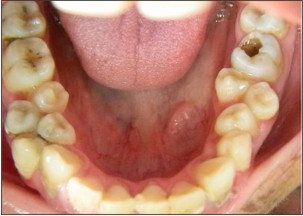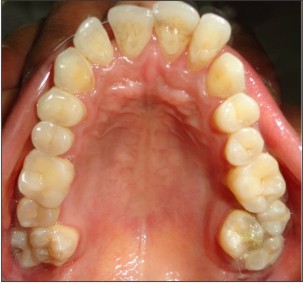Introduction
Supernumerary teeth are defined as a dental anomaly with the existence of excessive number of teeth in relation to the usual configuration of 20 deciduous and 32 permanent teeth.These may occur singly, multiply, unilaterally or bilaterally, erupted or impacted, in the deciduous as well as in permanent dentition and may closely resemble in size and shape to the tooth to which it is associated.[1],[2]
Supernumerary teeth may be classified as-[3]
1) Chronologically-predeciduous, similar to permanent teeth, postpermanent,complimentary
2) Morphologically- supplemental/eumorphic (similar to size and shape of the associated deciduous or permanent tooth) or rudimentary/ dysmorphic (odontome, conical, tuberculate, molariform)
3) Topographically-mesiodens/supernumerary premolars/paramolars/distomolars
The exact aetiology of supernumerary teeth is unknown and both genetic and environmental factors have been hypothesized. An autosomal dominant pattern of inheritance along with increased incidence in males to females ratio suggests the possibility of sex linked inheritance,[4] an abnormal reaction to trauma and disruption during embryologicformation has also been hypothesized that include:
1) proliferation and hyperactivity of the dental lamina;
2) remnants of epithelial cells;
3) supernumerary dental germs;
4) dichotomy of tooth germs.[5],[6]
These supernumerary teeth are frequently seen associated with various systemic diseases or disorders like-[7]
1) Gardener’s syndrome
2) Ehler-Danlos syndrome
3) Cleido-Cranial dysplasia
4) Cleft lip and cleft palate
5) Ellis-Van Creveld syndrome
6) Fabry–Anderson's syndrome
7) Incontinentia Pigmenti
8) Tricho–Rhino–Phalangeal syndrome
9) Megadontia
The occurrence of multiple supernumerary teeth without any systemic disease association, however, is a rare anomaly, with the most common site affected is the mandibular premolar region.[8] Single supernumeraries have been shown to occur in 76-86%, double supernumeraries in 12-23%, and multiple supernumeraries in <1% of cases.[9]
This case report presents two cases of nonsyndromic multiple supernumerary teeth where the supernumerary premolars and paramolars have developed in different sites. The first case presented in this report is a very rare case and is one of its kind with nonsyndromic 16 supernumerary premolar like teeth present and the second case shows presence of ectopic eumorphic supernumerary premolar and paramolar.
The cases also show the significance of radiographic correlation with the clinical examination performed and its impact on diagnosis and treatment of the patient.
Case Reports
Case 1
A 21 year old male patient reported to the outpatient department of Periodontics with the chief complaint of brownish-black deposits on his teeth and wanted regular cleaning of his teeth to be done. Familial, medical and dental histories were recorded and were found to be non-contributory. Extraoral examination did not reveal any abnormality. Intraoral examination revealed that the dentition comprised of full set of 32 permanent teeth, presence of supra and subgingival plaque and calculus and tooth number 36, 37, 46 and 47 were decayed. In addition to this, six supernumerary premolars (two in maxillary arch and four in mandibular arch) were present, presenting a total of 14 premolars being present in the oral cavity. In first and second quadrant, supernumerary teeth were present bilaterally in between central incisor and lateral incisor. Also, the first and second premolars bilaterally were rotated mesiodistally (Figure 1). In third quadrant, two supernumerary premolars were present, one buccally and another in linguoversion, in between second premolar and first molar. In fourth quadrant, two supernumerary premolars were in linguoversion adjacent to first and second premolars (Figure 2).
 | Figure 1- Intraoral photograph showing two supernumerary premolars in maxillary arch
 |
 | Figure 2- Intraoral photograph showing four supernumerary premolars in mandibular arch
 |
Orthopantomograph (OPG) of the patient revealed a very rare and unusual radiographic appearance with ten unerupted supernumerary teeth present (Figure 3). In the first quadrant, two supernumerary teeth were present at the apices of canine and first molar with the crowns in mesioangular and distoangular directions respectively. In second quadrant, a supernumerary tooth was present at the apex of second premolar. In third quadrant, three supernumerary teeth were present. Two supernumerary teeth were visible at the premolar-molar region. One of them was lying between the apices of first and second premolar and second one between the roots of second premolar and first molar (Figure 3). The third supernumerary in the third quadrant was lying horizontally in the parasymphyseal area at the apices of incisors. In fourth quadrant, four supernumerary structures were present at the apices of premolars in body of mandibular region. The radiographic calcified structures resembled the crown of developing premolars. The total number of supernumerary teeth in both the arches was six erupted and ten unerupted premolar like teeth. The patient, however, was unaware of this and was completely asymptomatic. Several clinical examinations were then performed to discard the presence of any systemic pathology and all showed normal results. At present the patient is kept on regular follow-up visits.
 | Figure 3- Orthopantomograph showing ten unerupted and six erupted supernumerary premolars in maxillary and mandibular arches
 |
Case 2
A 25 year old female patient reported to the department of Periodontics with the chief complaint of foul smell from the mouth since last 1-2 months. No significant familial, medical and dental history was reported by the patient. Extraoral examination revealed no abnormality. Intraoral examination revealed complete set of dentition with 32 teeth being present. In the first quadrant, a fully erupted ectopic eumorphic supernumerary premolar was present in between first and second molar. Third molar was bucally erupted. In second quadrant, a paramolar was present situated on the mesiobuccal surface of second molar. Also, the second molar was in linguoversion in both the quadrants (Figure 4). A panaromic radiograph was taken to confirm the examination (Figure 5). The patient was asymptomatic and unaware of any anomaly present and clinical examinations also showed normal results. The patient is kept on regular follow-up visits.
 | Figure 4- Intraoral photograph showing supernumerary premolar in first quadrant and paramolar in second quadrant
 |
 | Figure 5- Orthopantomograph showing presence of supernumerary teeth in maxillary arch
 |
Discussion
The presence of supernumerary teeth does not necessarily occur in conjunction to any type of malocclusion or as sequelae of any associated systemic disorder or syndrome. As in the cases presented in this paper, the discovery of multiple asyndromic and asymptomatic supernumerary calcified teeth like structures are often a very rare and unique entity.
The prevalence of supernumerary teeth has been reported differently in different studies due to differences in sample size, age groups, ethnicity and also applied radiographic techniques.[10] The prevalence of supernumerary premolars is a rare anomaly accounting to only 8.0 to 10% cases of all the super numeraries.[11]
Solares et al have reported that these supernumerary teeth may lie dormant at the apices of the permanent premolars and molars,[10] however cases have been reported in which these teeth may cause obstruction in eruption of permanent teeth[3] or may also cause root resorption of an adjacent tooth or may be associated with dentigerous cyst.[11]
The treatment of such cases is based on the interdisciplinary approach and on the critical decision of -
1) Removal of the supernumerary teeth or
2) maintenance of the supernumerary teeth with regular clinical and radiographic follow-up.
Timing of removal of unerupted supernumerary teeth is again a debatable issue and is not without risks. Early removal is recommended when the supernumerary is causing problems, such as the prevention of eruption or root resorption of the permanent teeth. When removing paramolars, there is a danger of damage to surrounding anatomic structures. Later removal of the supernumerary can often be carried out conveniently along with third molar removal. In all cases the risk and benefits of surgery must be carefully evaluated. Patients who are reluctant to accept the treatment should be carefully educated and motivated and should be kept under regular follow-ups.[3]
An unexpected finding in these two cases was that the full complement of permanent dentition was present, with rotated premolars in first case. Both the patients were completely asymptomatic and the presence of supernumerary teeth was an incidental finding. As seen in the presented cases, impacted supernumerary teeth were not associated with any cyst formation or resorption of the adjacent teeth, it was decided to observe and regularly evaluate these patients clinically and radiographically.
References
1. Leco Berrocal MI, Martin Morales JF, Matinez Gonzales JM. An observational study of the frequency of supernumerary teeth in a population of 2000 patients. Med Oral Patol Oral Cir Bucal 2007;12:E134-8.
2. Ganesan S, Loomba K,Wadhwani KK. Bilateral paramolars in maxilla with unilateral paramolar and supernumerary premolar in mandible: A case report. J Conserv Dent 2001;4:84-7.
3. Scanlan PJ, Hodges SJ. Supernumerary premolar teeth in siblings. Br J Orthod 1997;24: 297-300.
4. Brunning LJ, Dunlap L, Mergele ME. Report of supernumerary teeth in Houston Texas schoolchildren. Journal of Dentistry for Children 1957;24:98–105.
5. Fisher SE. Maxillary sixth molars. British Dent J 1982;152:356-9.
6. Nazif MM, Ruffalo RC, Zullo T. Impacted supernumerary teeth: a survey of 50 cases. J Am Dent Assoc 1983;106:201–4.
7. Rajab LD, Hamdan MA. Supernumerary teeth: Review of the literature and a survey of 152 cases. Int J Paed Dent 2002;12:244–54.
8. Yousof WZ. Non syndromal multiple supernumerary teeth: Literature review. J Can Dent Assoc 1990;56:147-9.
9. So LLY. Unusual supernumerary teeth. Angle Orthod1990;60:289-92.
10. Solares R, Romero MI. Supernumerary premolars: A literature review. Pediatr Dent 2004;36:450-8.
11. Hyun HK, Lee SJ, Ahn BD, Lee ZH, Heo MS, Seo BM, et al. Non syndromic multiple mandibular supernumerary premolars. J Oral Maxillofac Surg 2008;66:1366-9.
|